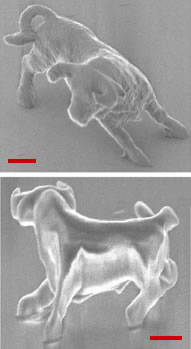Bull wins size
prizeMedicine and computers
could benefit from nano sculpture.
16 August 2001
JOHN
WHITFIELD
 |
| The smallest bull in the
world: red lines equal to 2 millionths of a
meter |
| © S. Kawata et
al. | | |
This bull is the size of a red blood cell. Its
Japanese creators hope that the technology they used to
make it will find applications in computing and
medicine.
Satoshi Katawa and colleagues at Osaka University
used two laser beams to sculpt the micro-beast from
resin, which solidifies only where the lasers cross. The
team refined this 'two-photon micropolymerization' to a
resolution of 120 nanometres (120 billionths of a
meter).
They chose a bull, says team member Hong-Bo Sun,
because it has a "very sophisticated three-dimensional
shape with sharp tips and a smooth and rough body".
"We dream that this bull pulls a drug cart through
the blood vessels," says Sun, suggesting that
similar-sized micromachines could one day travel,
Fantastic Voyage-style, around the body to treat
disease. The technique could also be used to make
microscopic sensors, templates for cell cultures and
three-dimensional computer memories.
The technology is still in its early days, however.
The time needed to build structures pixel-by-pixel could
be a problem, says chemist Bob Denning of the University
of Oxford. But the resolution of the sculptures is
"remarkable - it'll be very tough to get better," he
says. |


